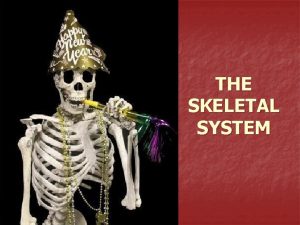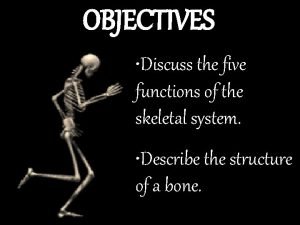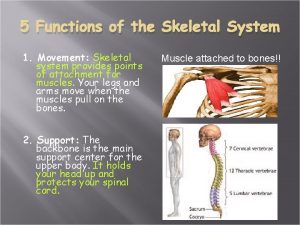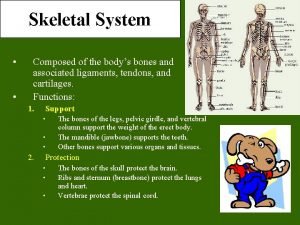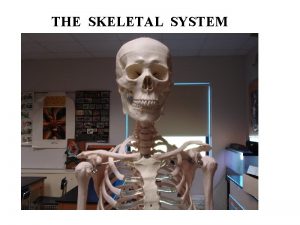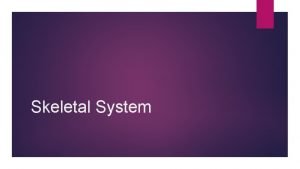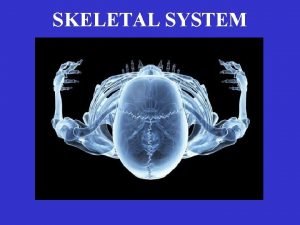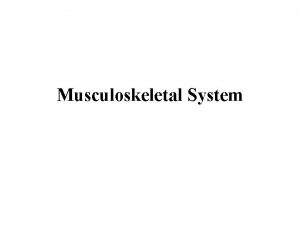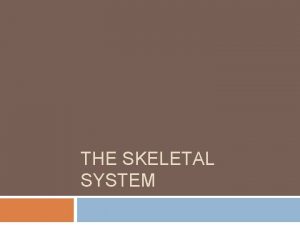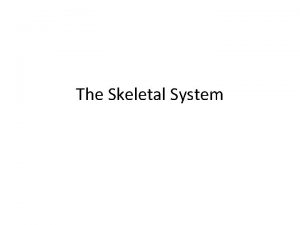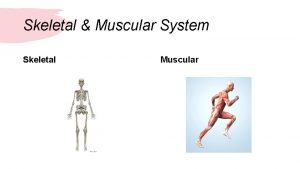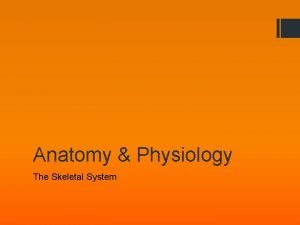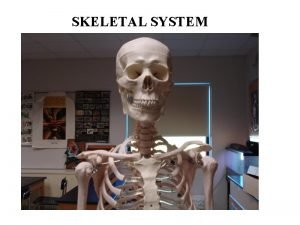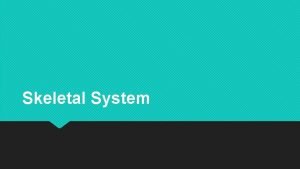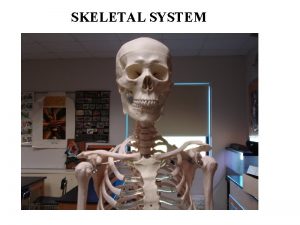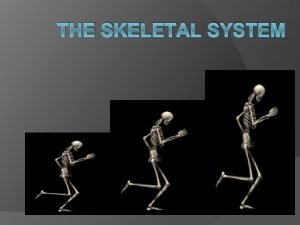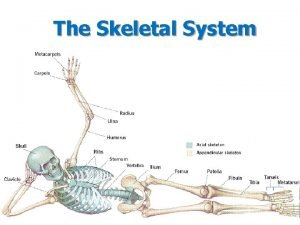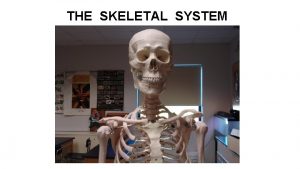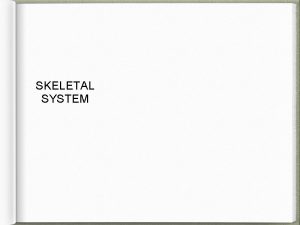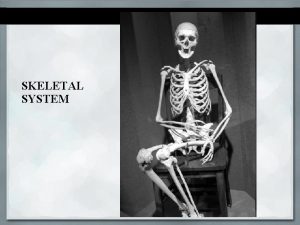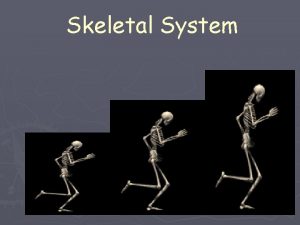Skeletal System Skeletal System Functions of the skeletal








































- Slides: 40

Skeletal System

Skeletal System • Functions of the skeletal • Skeleton =made up of various forms of connective tissue system – Musculoskeletal system • 2 systems work together – Support body – Allow movement • Consists of – Bones – Joints – Cartilage –Binds together and supports structures of the body • Bone • Tendons • Ligaments • Cartilage

Bone • Red bone marrow –Forms red/white blood cells –Clotting cells • One of the hardest tissues in the body • When in embryo = skeleton is made of cartilage and fibrous membranes –Harden into bone before birth • Ossification –Formation of bone from fibrous tissue –Continues until maturity • Normal bone continuously is built up and broken down throughout animals life –Allows bone to heal and repair itself

Types of Bones • Classified by shape – Long • Found in limbs • Support body weight • Act as levers for propulsion - Short Knee and hock Absorbs shock of joint - Flat Encircle cavities containing vital organs Ribs - Unpaired Vertebrae

Makeup of Bone

Composition of Bone • Mature bone – Composition • 25% Water • 45% Mineral – Calcium = 37% – Phosphorus = 18. 5% 30% Organic matter - Structure - Compact bone Provides rigidity and strength - Spongy bone Contains bone marrow

Osteoblasts • Osteoblasts – Oste/o = bone – -blasts = immature – Immature bone cells that produce bony tissue – When mature, become osteocytes

Red and Yellow Bone Marrow • Located in spongy part of bone • Red bone marrow –Hematopoietic • Hemat/o – blood • -poietic pertaining to formation –Produces red blood cells, white blood cells • Yellow bone marrow –In adult animals, in limb bones – replaces red bone marrow –Composed mainly of fat cells –Serves as fat storage area

Periosteum • • Covers bone Thin adherent membrane Protects bone Influences growth – Damage to periosteum usually means irregular bone growth Splints Spavins Ringbone

Bones • Skeleton divided into 2 parts –Axial skeleton • Includes –Skull –Vertebral column » Spine –Ribs –Sternum –Tail – Appendicular skeleton • Includes – Extremities – Shoulder – Pelvic girdle • Append = add or hang – Hang from axial skeleton

Axial Skeleton

Axial Skeleton - Skull • Cranium –Portion of skull that encloses the brain • Frontal –Forms roof of cranial cavity • “front” portion of skull • Parietal –Paired bones –Form roof of back cranial cavity • Occipital – Forms back part of cranial cavity • Where opening of spinal cord is • Temporal – Paired bones – Form sides and base of cranium – Temple is seen on outside of horse

Axial Skeleton - Skull

Axial Skeleton - Face • Zygomatic –Projections from temporal and frontal bones –Form cheekbone • Maxilla –Forms upper jaw • Mandible –Forms lower jaw • Lacrimal –Forms medial part of orbit • Incisive – Forms rostral part of hard palate and lower edge of nares • Nasal – Forms bridge of nose

Figure 5. 11

Vertebral Column – Spinal Cord • Supports head and body • Protects spinal cord • Made up of individual bones – Vertebrae • Divided into parts –Vary depending on location and function • Some vertebrae names – C 1 (cervical vertebrae #1) – Atlas - C 2 (cervical vertebrae #2) – Axis

Parts of the Vertebrae • Body –Solid portion ventral to spinal cord • Arch –Dorsal part that surrounds spinal cord • Lamina –Left or right dorsal half of the arch • Spinous process –Single projection from the dorsal part of the arch • Transverse process –Project caudolaterally from right and left sides of vertebrae • Articular Process –Paired cranial and caudal projections located at dorsum of arch • Foramen –Means opening –Opening in middle of vertebrae where spinal cord runs = vertebral foramen • Intervertebral discs – Cartilage discs that separate each vertebrae and provide cushion

Vertebrae

Vertebral Column - Five sections - Cervical - 7 vertebrae - Thoracic - 18 vertebrae - Lumbar - 6 vertebrae - 5 in Arabians - Sacral - 5 vertebrae - Fused to make sacrum - Coccygeal - Tail - 15 -21 vertebrae

Table 5. 1: Number of Vertebrae By Species Regions of Vertebral Column • Cervical “C” Neck area • Thoracic “T” Chest area • Lumbar “L” Loin area • Sacral “S” Sacrum area • Coccygeal Tail area

Thoracic Cavity - Chest cavity - Protects - Heart - Lungs - Vessels and nerves - Trachea and esophagus - Makeup - Thoracic vertebrae - Ribs - Paired bones - Attach to thoracic vertebrae - Sternum - Breastbone - Forms midline ventral portion of rib cage

JOINTS

Cartilage • Form of connective tissue • Diminishes effect of concussion • More elastic than bone –Useful in more flexible parts of the skeleton • Articular cartilage –Covers joint surfaces of bone – Diminishes effect of concussion – Provides smooth surface that reduces friction • Meniscus –Curved fibrous cartilage found in some joints • Cushion from force –Canine stifle


Joints • Also called articulations –Articulate • Join so that motion can occur between parts • Connections between bones • Different types of joints based on –Function –Degree of movement

Ligaments, Tendons, and Bursa • Ligament – Band of fibrous connective tissue – Connects bone to bone • Tendon – Band of fibrous connective tissue – Connects muscle to bone • Joint Capsule – Contains bursa – Fibrous sac – Acts as cushion • Ease movement in areas of friction – Shoulder joint • Bursa where tendon passes over bone

Figure 5. 8

Synovial Membrane and Fluid • Found in bursa and synovial joints –Inner lining • Synovial membrane –Secretes synovial fluid » Acts as lubricant for smooth joint action/movement



Appendicular Skeleton - Made up of: - Front (thoracic) and hind (pelvic) limbs - Thoracic girdle - Shoulder - Scapula - Clavicle - Pelvic girdle - Pelvis - Os Coxae - Ilium - Ishium - Pubis

Thoracic Bones - Bones of Upper Leg - Scapula - Shoulder blade - Clavicle - Humerus - Ulna - Radius - Bones of Lower Leg - Carpal bones - Bones of Knee

Pelvic Bones • Bones of Upper Leg – Pelvis (hip) • 3 pairs of bones –Ilium –Ischium –Pubis – Femur – Patella – Tibia – Fibula - Bones of Lower Leg - Tarsal bones - Bones of hock

Lower Limbs - Carpal bones - Knee (carpus joint) - Tarsal bones - Hock (tarsus joint) - Metacarpus bones - front limb - Metatarsus bones - hind limb - Four in horses - One major - Third metacarpus/metatarsus - Cannon bone - Two minor - Second and fourth - Splint bones Front Leg

Lower Limbs con’t - One digit - Middle finger of humans - Three phalanges - First/proximal phalanx (long pastern bone) – P 1 - Second/middle phalanx (short pastern bone) – P 2 - Third/distal phalanx (coffin or pedal bone) – P 3 - Joints - Cannon and 1 st phalanx = fetlock joint - 1 st and 2 nd phalanx = pastern joint - 2 nd and 3 rd phalanx = coffin joint - Sesamoid - Two proximal - Near fetlock - One distal (navicular) - Near coffin

The Equine Hoof

The Equine Hoof

Ligaments and Tendons Suspensory Ligament - Strong and flat - Extremely elastic - Most prone to injury - Runs along back of leg between splint bones - Splits at fetlock, attaches to sesamoids and runs towards front of joint - Joins extensor tendon and attaches to front of coffin bone

Superficial Digital Flexor Tendon - Runs down the back of the leg - Branches below the fetlock and inserts onto 1 st and 2 nd phalanx - Flexes the elbow, carpus and lower joints Check Ligament - Short and strong - Runs from upper end of suspensory to just below knee and attaches to superficial flexor tendon

Nuchal Ligament - Elastic ligament extending from poll to withers - Assists neck muscles in holding head and neck in position
 5 main functions of the skeleton
5 main functions of the skeleton Five functions of the skeletal system
Five functions of the skeletal system 5 functions of skeletal system
5 functions of skeletal system Crash course skull
Crash course skull 5 functions of skeletal system
5 functions of skeletal system Sagittal suture
Sagittal suture Functions of skeletal muscle
Functions of skeletal muscle Hát kết hợp bộ gõ cơ thể
Hát kết hợp bộ gõ cơ thể Frameset trong html5
Frameset trong html5 Bổ thể
Bổ thể Tỉ lệ cơ thể trẻ em
Tỉ lệ cơ thể trẻ em Chó sói
Chó sói Tư thế worms-breton
Tư thế worms-breton Chúa yêu trần thế alleluia
Chúa yêu trần thế alleluia Các môn thể thao bắt đầu bằng tiếng nhảy
Các môn thể thao bắt đầu bằng tiếng nhảy Thế nào là hệ số cao nhất
Thế nào là hệ số cao nhất Các châu lục và đại dương trên thế giới
Các châu lục và đại dương trên thế giới Công thức tính độ biến thiên đông lượng
Công thức tính độ biến thiên đông lượng Trời xanh đây là của chúng ta thể thơ
Trời xanh đây là của chúng ta thể thơ Cách giải mật thư tọa độ
Cách giải mật thư tọa độ Phép trừ bù
Phép trừ bù độ dài liên kết
độ dài liên kết Các châu lục và đại dương trên thế giới
Các châu lục và đại dương trên thế giới Thơ thất ngôn tứ tuyệt đường luật
Thơ thất ngôn tứ tuyệt đường luật Quá trình desamine hóa có thể tạo ra
Quá trình desamine hóa có thể tạo ra Một số thể thơ truyền thống
Một số thể thơ truyền thống Bàn tay mà dây bẩn
Bàn tay mà dây bẩn Vẽ hình chiếu vuông góc của vật thể sau
Vẽ hình chiếu vuông góc của vật thể sau Biện pháp chống mỏi cơ
Biện pháp chống mỏi cơ đặc điểm cơ thể của người tối cổ
đặc điểm cơ thể của người tối cổ V. c c
V. c c Vẽ hình chiếu đứng bằng cạnh của vật thể
Vẽ hình chiếu đứng bằng cạnh của vật thể Vẽ hình chiếu vuông góc của vật thể sau
Vẽ hình chiếu vuông góc của vật thể sau Thẻ vin
Thẻ vin đại từ thay thế
đại từ thay thế điện thế nghỉ
điện thế nghỉ Tư thế ngồi viết
Tư thế ngồi viết Diễn thế sinh thái là
Diễn thế sinh thái là Các loại đột biến cấu trúc nhiễm sắc thể
Các loại đột biến cấu trúc nhiễm sắc thể Số nguyên là gì
Số nguyên là gì Tư thế ngồi viết
Tư thế ngồi viết
